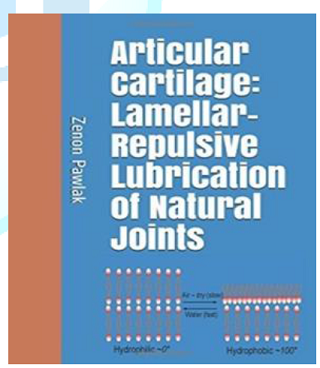Commentary :
This monograph attempts to explain a new joint
lubrication mechanism with surface active phospholipids as a lubricant. It
provides studies of the principles of cartilage (smart material) of biological
micro- and Nano tribology. The concepts presented in this
monograph "lamellar-electrostatic mechanism" are new and compatible
with the discovery of Prof. Brian Hillss hypothesis that lamellar phases of PLs
and phospholipid bilayers are lubricants in natural joints. The concept that
boundary lubrication in joints was mediated by an active ingredient in Synovial
Fluid (SF) was put forward by Jones (1934), Linn and Radin (1968) and Hills
(1984). According to Hills and other authors, the Surface Amorphous Layer (SAL)
of cartilage contains surface-active phospholipids.
Phosphatidylcholines (over 40%)
sphingomyelin (~30%) and phosphatidylethanolamines (~30%) were subsequently
identified in the synovial fluid and SAL. This book is focused on the mechanism
of natural lubrication by which the Phospholipids (PLs) in Articular Cartilage
(AC) act as a lubricant. The physiological function of PLs is unique in
preventing solid-solid contact and degradation of the articular surface. With
AC, it is particularly important to have a model where PLs adsorbed on the
surface of cartilage impart a number of highly desirable properties. The importance of basic properties of the
cartilage such as the surface energy, wettability, pH, surface charge, and
amphoteric surface character were determined and turned out to be compatible
with some features of joints lubrication. While the principal aim of the book
was to provide an understanding of the meaning of the surface-active state
(lamellar bodies), the other is to highlight the solid PL bilayers that possess
low surface energy at pH ~7.4, when applied to the body. The understanding of
AC amphoteric surface will be essential for the effective repair and
regeneration of the degraded knee joint. In conclusion, it can be stated
that the lamellar-electrostatic lubrication mechanism, a new approach to
understanding natural lubrication, is challenging and deserves to be studied. This monograph is intended for
advanced undergraduate and graduate medical and biomechanical students and
researchers in the area of biomechanics and biological systems. Reviewer: Tadeusz
Kaldonski Citation: Kaldonski
T. Opinion article: articular cartilage:
lamellar-repulsive lubrication of natural joints by zenon pawlak (2018) Edelweiss
Appli Sci Tech 2: 278-279. Articular Cartilage, Natural Lubrication,
Lamellar-Repulsive Mechanism of Lubrication of Natural Joints.
Opinion Article: Articular Cartilage: Lamellar-Repulsive Lubrication of Natural Joints by Zenon Pawlak
Abstract
Full-Text

Keywords